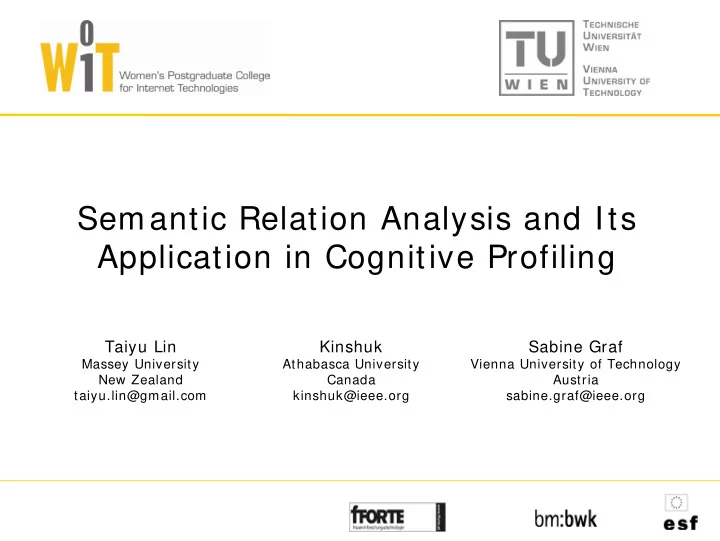

Semantic Relation Analysis and Its Application in Cognitive Profiling Taiyu Lin Kinshuk Sabine Graf Massey University Athabasca University Vienna University of Technology New Zealand Canada Austria taiyu.lin@gmail.com kinshuk@ieee.org sabine.graf@ieee.org
Motivation � What is cognitive profiling? Process of detecting the cognitive abilities of learners such as � Working memory capacity � Inductive reasoning ability � Associative learning skills � … � Why do we need cognitive profiling? � Avoid cognitive overload for learners � Using information about learners for adapting courses with respect to the learners’ cognitive abilities 2
How to get information about the learners? Student Modelling Automatic Student Collaborative Student Modelling Approach Modelling Approach Content-less Content-based Navigational Navigational Pattern Analysis Pattern Analysis 3
Content-less navigational pattern analysis � Every webpage is treated as a node � Every webpage is treated equally regardless of its content � Relationships between the nodes are not defined � Focus is on the navigational behaviour (certain navigation patterns indicate navigation approaches such as searching or browsing) � domain-independence � Reusable across different domains � Inaccurate in specific situations 4
Content-based navigation pattern analysis � Primary analysis method for most of the performance- based student models, recording students’ progresses and grades � Contextualised semantic information of every node is recorded (based on domain ontology or concept map) � Learning system makes inferences about the learners and stores the information in the student model � Benefit: Accurate due to semantic information � Drawback: Domain-dependence � For a new domain, similar effort of analysis have to be carried out � For modifications in the domain ontology, inferences rules have to be re-written 5
Semantic Relation Analysis (SRA) � Based on the idea of Semantic Web � Uses semantic information about relationships between learning objects � Two learning objects can be related to each other in different ways � Learning Object Metadata (LOM) already defines 12 different types: � IsPartOf, HasPart � IsBasedOn, IsBasisFor � Requires, IsRequiredBy � References, IsReferencedBy � IsVersionOf, HasVersion � IsFormatOf, HasFormat � Is extended by Vijver et al. (2002) by the types HasExample , ExcursionTo , and Evaluates � Through categorising of relationships, SRA is domain independent but contains semantic information 6
Semantic Relation Analysis for Cognitive Profiling � Semantic Relation Analysis is applied in the Cognitive Trait Model (CTM) to discover information about the learners’ cognitive traits Tr Trait M Model l Trait M t Model el Ga Gatewa teway y Performance Pe Based M ed Model el t. Action Ac Individualized ed Trait N t Netwo tworks Co Compo ponent. ory Hi Histor Acti tion H History C y Component t … … ITN 1 ITN 2 ITN n Interface L Listen ener C Componen ent MOT D Detector or C Comp mpon onent … …… . MOT 1 MOT 2 MOT n Lear arne ner I r Interface rface 7
Empirical Study with respect to Inductive Reasoning Ability � Participants: 29 students from Massey University, New Zealand (studying in Information Systems course) � Participants used a learning system that tracked their behaviour � Read the descriptions of the concepts � Take a quiz consisting of multiple-choice questions � Participants were asked to perform a web-based inductive reasoning test (Web-IRA) � Consists of 30 questions, including 3 types of tasks (series extrapolation, analogical reasoning and exclusion) � Questions are presented in a sequential order and must be solved in this order � Online accessible � Time mechanism is built for detecting abnormalities 8
Analysis and Results � The number of correct answered questions in Web-IRA was used as index of inductive reasoning ability � Inductive reasoning ability was also calculated through the cognitive trait model based on semantic relation analysis � The conducted rank correlation analysis showed a significantly correlation between the results of both approaches (rho= 0.382, p= 0.02) � Results supports the use of SRA in cognitive profiling 9
Conclusion � Introduced a novel approach called Semantic Relation Analysis, which combines the strengths of content-less and content-based navigational pattern analysis by using semantic information about relationships between learning objects � Demonstrated exemplary application of the Semantic Relation Analysis for identifying inductive reasoning ability � The result of the empirical study showed a significant correlation between the automatic student modelling approach by semantic relation analysis and the collaborative student modelling approach by using Web-IRA � This result supports the proposed approach of using SRA for cognitive profiling � Future work: � Identifying more new potential application areas of SRA � Exploring how it can be integrated into the tracking service of SCORM in order to provide easy integration mechanism for learning system developers 10
Recommend
More recommend